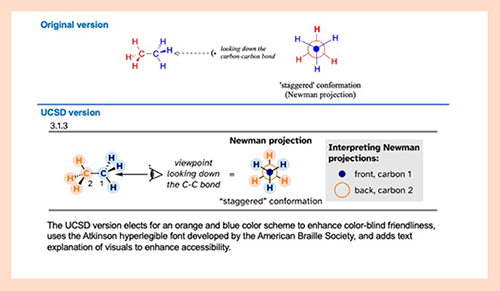Organic Chemistry for Life Sciences (40AB)
June 19, 2023 | By Michelle Franklin
Organic chemistry is the study and analysis of carbon-containing compounds, which make up all living organisms. Today, the field of organic chemistry includes not just living organisms, but also carbon-containing, human-made substances such as plastics. In this inaugural edition of deCLASSified, we take a look inside a new course geared toward life sciences majors.
Class Overview
Organic chemistry has traditionally been offered as a three-quarter-long course series meant to prepare chemistry and biological sciences majors for their upper-division chemistry and biochemistry courses. The course also prepared students for professional school standardized exams, such as the MCAT and PCAT.
Over the 2021-2022 academic year, instructors decided to separate the course into two separate sequences: a three-quarter-long sequence for physical sciences and engineering majors and a two-quarter sequence for life sciences majors. This allowed instructors to address the different needs of these groups and reduce time-to-degree for life sciences majors.
 Professor Haim Weizman, a senior teaching faculty member in the Department of Chemistry and Biochemistry, explained that “while the concepts of organic chemistry are not different depending on the intended audience, context plays an important pedagogical role. The context for physical sciences and engineering majors may be a practical one where concepts are learned and presented so that hands-on experimentation using chemicals in laboratory or industrial settings can be carried out. Whereas life sciences majors are better served when organic chemistry concepts are placed in the biological contexts where they explain metabolic processes, physical properties of biopolymers, and drug-interactions.”
Professor Haim Weizman, a senior teaching faculty member in the Department of Chemistry and Biochemistry, explained that “while the concepts of organic chemistry are not different depending on the intended audience, context plays an important pedagogical role. The context for physical sciences and engineering majors may be a practical one where concepts are learned and presented so that hands-on experimentation using chemicals in laboratory or industrial settings can be carried out. Whereas life sciences majors are better served when organic chemistry concepts are placed in the biological contexts where they explain metabolic processes, physical properties of biopolymers, and drug-interactions.”
Shreya Srinivasan, a neurobiology major, enjoyed learning about chemical mechanisms with a biological emphasis because “I love being able to form connections between the concepts taught in organic chemistry and what I am now learning in my metabolic biochemistry course.”
Which students should take this class?
Undergraduate life sciences majors, which includes biological sciences, and other interested students who are not physical sciences and engineering majors.
How often is this class offered? How many students enroll?
The new sequence debuted in Fall 2022 and over 2,000 undergraduate students enrolled in the first two quarters alone. The courses will be offered every quarter and in summer sessions.
What makes this course unique?
There are several elements to this course that separate it from traditional organic chemistry courses.
- Curriculum shift. Traditionally, organic chemistry courses focus on synthetic transformations in laboratory settings. The new curriculum centers around the function and reactivity of molecules within biological systems. It emphasizes the logic behind how and why organic molecules behave the way they do in metabolic pathways, the action of drugs, and other biologically relevant applications. In fact, Henry Li, a human biology major, said, “An interesting thing I picked up from the class was the chemistry of benzoyl peroxide, and how the radicals it readily forms confers bactericidal effects in its application as an acne medication.”

- Enhancing equity and accessibility. Moving to free-of-charge Open Educational Resources (OER) eliminates textbook costs for students and allows instructors to customize the content and presentation. The instructors adopted a textbook by Timothy Soderberg called Organic Chemistry with a Biological Emphasis and obtained his permission to use it as the basis for a UC San Diego-specific edition. The first-year revisions by the workgroup included the reconstruction of nearly all illustrations and chemical structure figures in the textbook to better align content coverage with lecture material and the adoption of more accessible color schemes suitable for color-blind individuals and hyperlegible fonts to enhance readability. This will be available on the department website soon.
- Improving pedagogy. The new sequence is built on shared learning outcomes that allow instructors to provide similar learning experiences across various offerings of the course, including shared worksheets to provide a more uniform instructional experience for students. These worksheets emphasize and provide guided practice to promote student success. The use of real drug molecules, enzyme co-factors and lipids has been incorporated as examples of key chemical reactions throughout, rather than relying on generic molecules to demonstrate the same core concepts.
What students are saying about the class:
“I found the concept of chirality in biological systems quite fascinating. By changing the orientation of just one atom, the function of a molecule in an organism can be completely altered — so much biological diversity is achieved in this way!” –Elizabeth Wong, microbiology major
“The class really helped me understand the chemical mechanisms behind the reactions that occur in our body, especially in solidifying concepts in biochemistry and even molecular biology.” –Sarah Bergendahl, neurobiology major
"The new 40 sequence tailored toward biology students is such a big improvement. I believe everything we have learned thus far was interesting and pertinent to my goals. The textbook did a good job reflecting the new changes and the new material being taught in ochem. I cannot recommend the new 40 sequence enough." --anonymous
Photo credit: Erik Jepsen / UC San Diego

